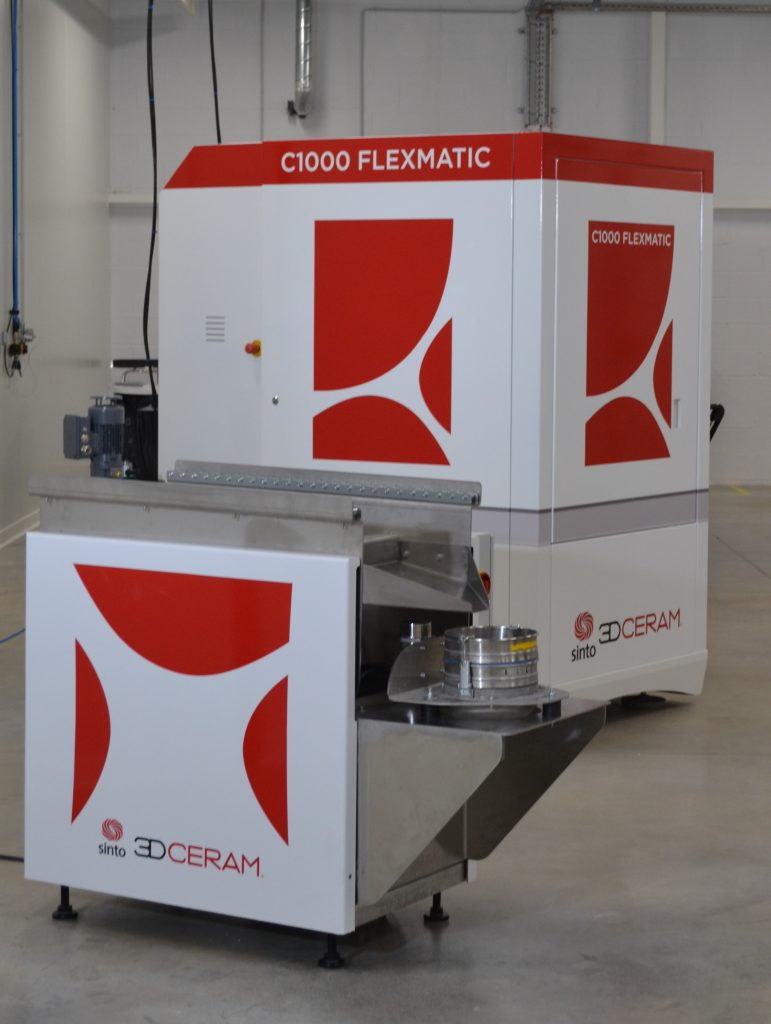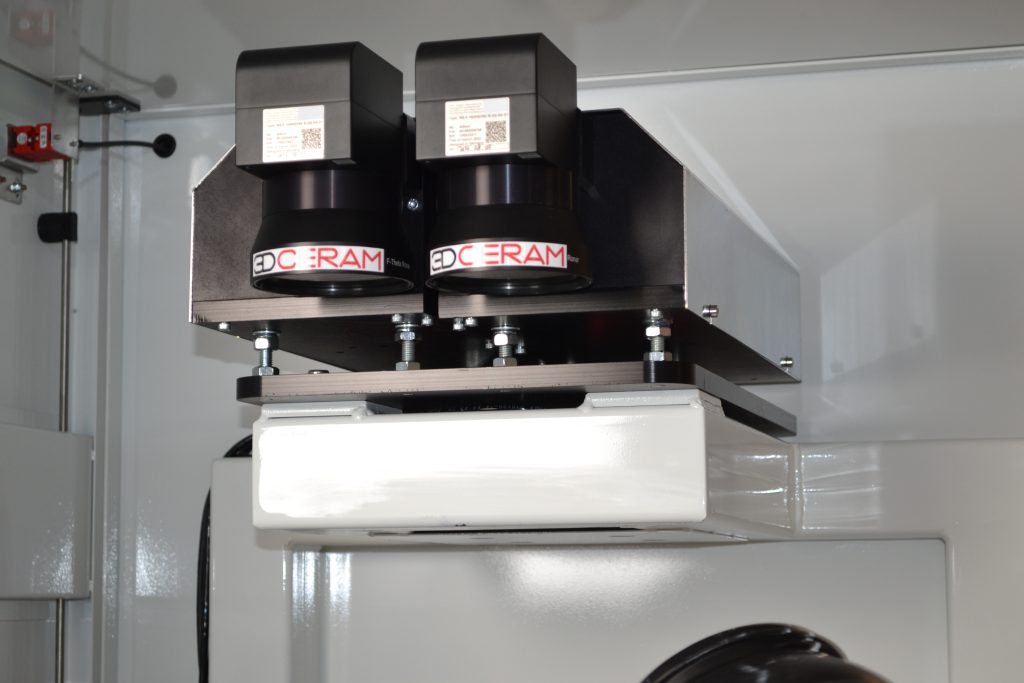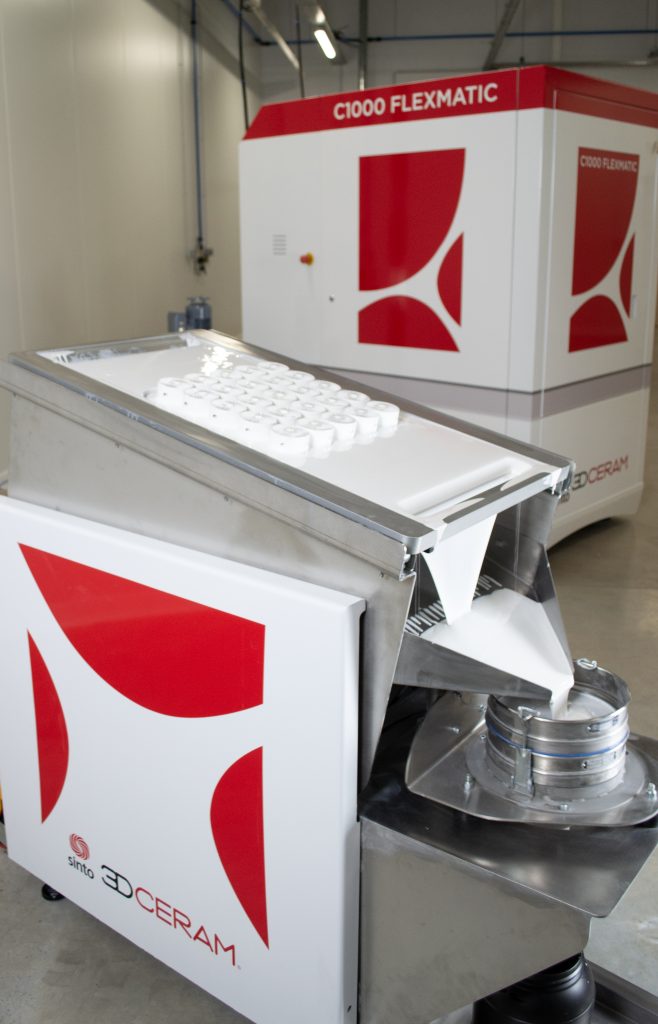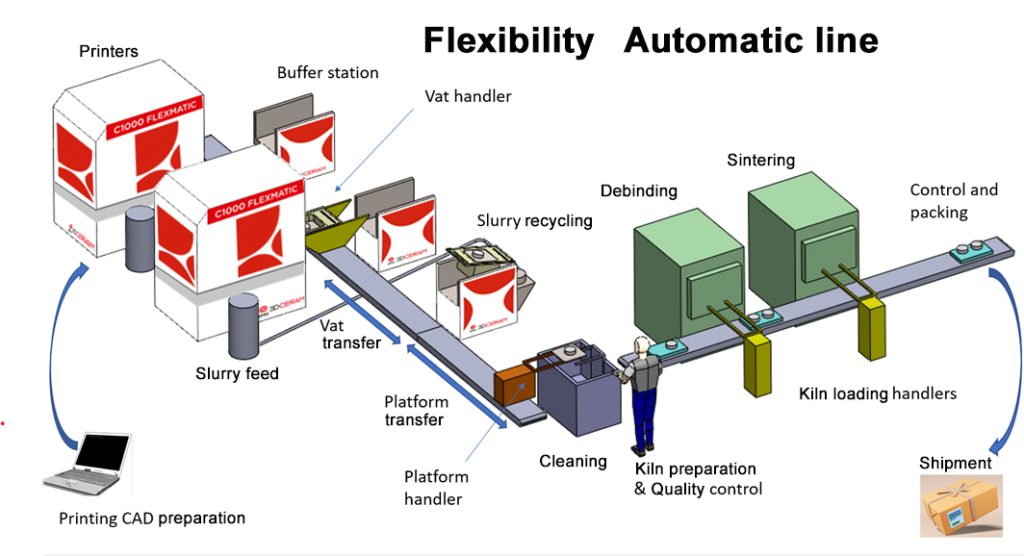Nominate now for the 3D Printing Industry Awards 2023.
Limoges-based ceramics 3D printing OEM and process provider 3DCeram Sinto is automating the 3D printing process for technical ceramics and the production of green hydrogen through its 3D printing technology.
Automation and digitization are becoming increasingly key to additive manufacturing, with 3DCeram Sinto striving for better, faster, and cheaper production. Indeed, more and more industries are adopting 3D printing technology, with additive manufacturing being increasingly viewed as a high-potential industrial tool. “Initially considered as a prototyping tool, 3D printing is now being viewed as a production tool,” commented Richard Gaignon, CEO of 3DCeram Sinto.
To achieve this high-level of automation, 3DCeram Sinto offers a range of 3D printers including the C3600 ULTIMATE large-format 3D printer, and the new C1000 FLEXMATIC semi-automated 3D printer. This technology can be incorporated into automated production lines, ideal for industrial manufacturing applications.
“Thanks to the combination of ceramic additive manufacturing and Sinto Group’s expertise in automation, we can now consider implementing fully automated production lines,” added Richard Gaignon. “Robots and automated production systems can handle all stages, from design to firing of the parts, with minimal direct human intervention.”

3D printing as a production tool
3DCeram has outlined a number of prerequisites for successfully industrializing the additive manufacturing process.
One prerequisite is efficiency and productivity, with production processes needing to significantly increase efficiency and productivity compared to existing production methods to become industrial.
In relation to additive manufacturing, the ability to create products with improved geometries that were previously impossible using alternative methods is also highlighted as being essential for industrial manufacturing. This applies to products or components that need to be manufactured as a single piece to avoid assembly challenges, such as foundry cores.
Moreover, in terms of industrialization, stereolithography is said to be a significant asset thanks to its top-down construction process. Here, layers are 3D printed from the bottom to the top, foregoing the use of many supports. Once 3D printed, the parts can be cleaned, and the fewer supports there are, the easier and quicker the production process becomes. Additionally, risks of waste due to possible breakage during support removal are also reduced through this process.
3DCeram calls this a major advantage, unleashing the capacity to design highly customized parts that meet specific industrial needs. Moreover, it is highlighted that multiple 3D printers can be added to a production line, while still being manageable by a single operator. This further increases productivity.
The company also identifies quality and reliability as key to industrialization, with mass-producing industries seeking repeatability and a consistent level of quality across all 3D printed parts. These parts must also comply with industry standards and meet user requirements. 3DCeram asserts that significant progress has been made in this area, allowing for the large series production of parts that meet the criteria of many industries.
Adaptability is also noted as an important quality, with the production technology needing to be adaptable to different production volumes according to demand. Additive manufacturing excels in this area, according to 3DCeram, as it offers “mass customization.” This enables the production of different product series in a single run, provided that the printing bed’s capacity allows it.
Ease of integration is also highlighted as being key to enabling industrialization, with the additive manufacturing process needing to operate in an automatic assembly line to be industrial.
To enable this automation, and address concerns relating to design limitations, 3DCeram developed its “Build It” plugin. This software plugin is an optional addition to the CPS machine software, and offers numerous features to prepare 3D printing tanks, optimize the arrangement of parts for 3D printing, and check and repair 3D printing files.
What’s more, a new version of the CPS machine software called CPS 2.0 was recently released to allow for greater industrialization of additive manufacturing. For instance, this new software includes a “C-Print” mode, allowing a single operator to launch a production process in just a few simple clicks.
Training is also outlined as being crucial to adopting 3D printing for industrial applications. “At our scale, we have implemented a comprehensive training program for our machines and processes, which is included in the initial package. As is customary with machine tools, guidance is necessary, and we take pride in being more than just a supplier – we strive to be a true partner to our industrial clients. That’s why we place great importance on the quality of our training programs,” explained 3DCeram Sales Director Maxence Bourjol. “In terms of training content, we offer extensive support that allows us to share our expertise and bring our partners to a level of proficiency that grants them full autonomy upon completion of the training.”

Automatic production lines: a revolutionary approach
Through its combination of ceramics 3D printing and an expertise in automation, 3DCeram Sinto now offers fully automated additive manufacturing production lines from design to post-processing. This significantly increases efficiency and reduces production costs, paving the way for new applications in various industrial sectors.
“We have a major asset, our stereolithography technology! It allows for the automation of 3D printing of technical ceramics due to its unique characteristics (few to no supports, large printing platforms, etc.) that enhance efficiency, precision, and process reproducibility,” explained Bourjol.
Indeed, the large build volumes of stereolithography 3D printers makes them especially well suited to mass production applications. Four years ago, 3DCeram launched the C3600 ULTIMATE, the company’s largest 3D printer with a build volume of 600 x 600 mm. Equipped with four lasers, the C3600 can produce large quantities of parts at substantial 3D printing speeds which meet industrial needs.
3DCeram’s latest 3D printer, the C1000 FLEXMATIC, is also well suited to industrial production, with a semi-automated production version of the C1000 FLEXMATIC also available. This 3D printer can be equipped with 2 lasers to optimize 3D printing speed, making it ideal for industrial customers with mass 3D printing goals. A material recycling station can also be added to the C1000 FLEXMATIC, reducing material waste and boosting automation.
This stereolithography offering also allows for excellent precision and fine details on optimized geometries, making it suitable for applications where dimensional accuracy is required.

How to successfully implement an automatic 3D printing line
When developing an industrial 3D printing manufacturing line for technical ceramics, close collaboration between the supplier and the customer is vital.
“Although several machines can be integrated into an automatic line, each implementation is unique, as it depends on the specific manufacturing project of the customer, the products that will be dedicated to the line, and the installation location,” commented Gaignon.
By closely collaborating, the supplier and the customer can anticipate potential challenges, optimize the line configuration, identify key functionalities, and maximize operational efficiency. This ensures a smooth and successful implementation of the industrial 3D printing manufacturing line.
“Our machines are equipped with advanced sensors that monitor manufacturing parameters in real-time, allowing adjustments to the process conditions and ensuring the quality of the parts at the end of printing,” explained Bourjol. “We are already able to offer automated lines to our customers today.”

Optimizing High-Pressure Hydrogen production with AM
3DCeram’s 3D printing technology is also being employed as part of the European HyP3D Project. Leveraging cutting-edge 3D printing manufacturing techniques, the project aims to showcase the viability of a disruptive high-pressure Solid Oxide Electrolysis Cell (SOEC) technology.
The HyP3D project seeks to deliver an ultra-compact, high-pressure standalone SOEC stack capable of converting electricity into compressed hydrogen. This project aims to harness 3D printed SOEC cells with a substantial active area of 70 cm2, embedded functionalities, and the capacity to achieve hydrogen production at high current densities exceeding 0.90A/cm2 (~1.3V) under conditions of 850°C and 5+ bar pressure.
3DCeram’s role in this project relates to an intricate optimization process spanning 3D printable feedstock Zr8Y, 3D printing parameters, and thermal treatments. By formulating specialized slurries for SLA 3D printing utilizing commercial YSZ powders, the teams are studying rheological behavior and conducting 3D printing tests. The innovation extends to designing optimal procedures, culminating in the production of complex-shaped parts mirroring the final cell dimensions.
3DCeram will utilize the C1000 Flexmatic as part of a semi-automatic production line. With a 320 x 320 mm build volume, the C1000 Flexmatic is said to be essential for the successful completion of the project.
HyP3D is said to represent a paradigm shift from traditional ceramics SOEC processing. This new process will create ultra-high power density SOEC stacks, boasting a power output of 2.14 kW within a compact volume of 630 cm3. As such, this will create a threefold increase in specific power per unit volume (3.4 kW/L) and a fourfold rise in specific power per unit mass (1.10 kW/kg).
Additionally, 3DCeram is collaborating with IREC to formulate optimal 3D printing strategies, ensuring reliability and maximizing production yield. This project aligns with the broader objectives of advancing the hydrogen economy, reducing time-to-market significantly, slashing raw material consumption by 76%, and minimizing the initial investment by 42% compared to conventional manufacturing processes.
Subscribe to the 3D Printing Industry newsletter to keep up to date with the latest 3D printing news. You can also follow us on Twitter, like our Facebook page, and subscribe to the 3D Printing Industry Youtube channel to access more exclusive content.
Are you interested in working in the additive manufacturing industry? Visit 3D Printing Jobs to view a selection of available roles and kickstart your career.
Featured image shows the C1000 FLEXMATIC’s two lasers. Photo via 3DCeram.


